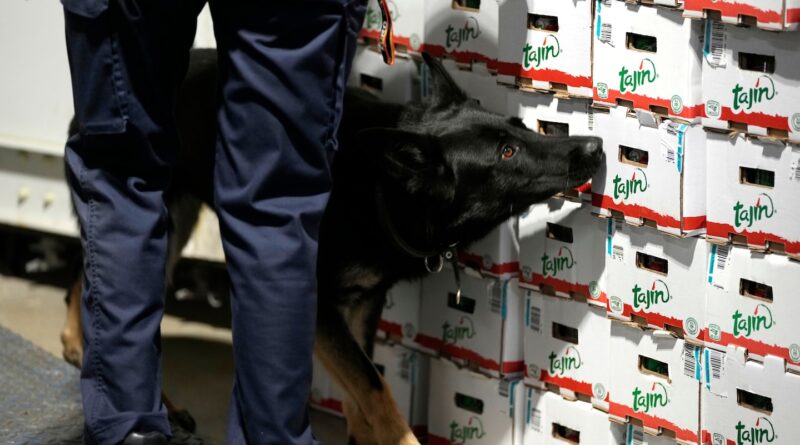A Belgian port seized tons of cocaine. Criminals tried to take it back.
Antwerp, known historically as a hub for diamond trading, has developed a reputation as Europe’s cocaine-import capital. Last year, Belgian customs officers intercepted a record 256,000 lbs. of cocaine there, according to figures shared this week by the Belgian ministry of finance.
That’s more than three times the amount U.S. customs and border officials seized in all of the United States. But officials estimate it’s only a fraction of the drugs being smuggled among the 12 million containers that pass through Antwerp each year.
The head of Belgium’s customs service said in an interview that especially big seizures in the fall appeared to have prompted a violent backlash, along with a new issue: Authorities haven’t always been able to destroy what they’ve confiscated before drug gangs try to steal it back.
“Attacking the police, attacking the customs, this is not something you see in Europe,” said Kristian Vanderwaeren, director general of Belgium’s customs agency. “I was really afraid that my people would be killed if this would continue.”
The port of Antwerp is massive, covering an area nearly the size of Pittsburgh. Twenty-thousand ships docked there last year, making it Europe’s second-busiest port behind Rotterdam in the Netherlands. After Dutch authorities stepped up their drug enforcement, smugglers shifted more of their operations to Antwerp, said Stijn Hoorens, a drug trade and policy researcher at RAND Europe.
Shipments increase as the holiday party season approaches, Vanderwaeren said, creating what he called a “white Christmas” at the port. On Nov. 3, the same day as the customs facility break-in, authorities seized 16,500 lbs. of cocaine hidden in boxes of bananas from Ecuador.
Confiscated cocaine shipments were piling up in customs facilities. Dutch authorities quickly incinerate seized drugs. But the Belgian government didn’t have the capacity to do that. And because drug gangs tend to track their shipments with digital locator devices, they can easily locate cocaine that hasn’t been removed from its container.
“The criminal organization was not afraid to come to a facility and capture their cocaine, even if it meant they would kill a customs officer,” Vanderwaeren said.
On that night in November, some of the customs workers were able to barricade themselves in an office and call the police. The assailants escaped — leaving behind the drugs they presumably came for — before they could be caught and before anyone was hurt.
In another recent episode, masked Belgian SWAT commandos rammed into a black SUV driving near the port and arrested seven armed men. Police had acted on intelligence that the men were heading to steal seized cocaine. Like the Nov. 3 attack, the episode happened on the same day as a big seizure — when officials intercepted “several tons” of cocaine in a shipment of soy meal from Sierra Leone.
And in December, an arson attack torched a customs warehouse storing confiscated cars and weapons in the south of the country, in what officials suspect was an act of retaliation for customs seizures.
After the recent attacks, the Belgian military was deployed to guard customs trucks and facilities. Vanderwaeren said he received more resources to destroy the drugs, too, so that he can now incinerate most seizures within one or two days. Destroying a major cache like the ones intercepted in the fall could still present a challenge.
Last week, Belgium’s federal police force announced it had raided 45 properties, arresting 22 people, including three police officers, connected to the drug trade.
The seizures and arrests don’t yet appear to have disrupted the business model of criminal gangs. Street prices for cocaine have stayed fairly stable over the past several years, even as quality increases, Hoorens, the drug trade expert said. Production is increasing in Latin American and drug cartels are becoming more sophisticated, integrating with European crime rings and building their own facilities in Europe for processing the drugs, he said.
According to Europol, the European Union’s law enforcement agency, Ecuador and its main port of Guayaquil have been the biggest sources of cocaine destined for Europe, reflecting how Mexican and Albanian gangs have infiltrated the country. This month, the president of Ecuador declared a “state of war” against drug gangs, after a series of assassinations, prison breaks and bombings there.
In export countries, gangs bribe or extort port workers to allow them to hide cocaine among legal shipments. Smugglers favor containers filled with perishable goods, such as fruit and fish, which puts more pressure on port and customs workers to move the containers along quickly, Hoorens said. Sometimes the drugs are stuffed into a duffel bag thrown into a random container. Sometimes the methods are more complex.
Belgian authorities have found cocaine packed into hollowed-out logs and pineapples. The drug can also be washed into fabric, left to dry and then processed back into powder once it has reached its destination.
Customs officials use giant X-ray machines to look inside containers without opening them up. But scanning more than a small percentage of the tens of thousands of containers that go through the port of Antwerp each day isn’t an option.
“There’s absolutely no way that that’s possible,” Hoorens said. “Any container that is subject to scanning will cause delays, and delays cost money.”
Huge amounts of drugs make it through in containers that are never searched.
Across Europe, ports are in competition with each other to attract commercial shipments. Antwerp is just 40 miles from Rotterdam. Smaller ports such as Vlissingen in the Netherlands, Le Havre in France and Hamburg in Germany are all keen for more business.
“If Rotterdam and Antwerp step up their game, they will seek alternative routes,” Hoorens said of drug smugglers.
This month, Belgium took over the rotating presidency of the Council of the European Union, a position that lets the country set the high-level agenda for part of the European Union’s government. Increasing cooperation on drug enforcement between European ports is one of Belgium’s key priorities for its six-month term.
Drug violence has flared in recent years in both Belgium and the Netherlands. In 2021, a well-known Dutch crime reporter was murdered after helping advise a former gangster who was testifying against a drug kingpin. Belgium’s justice minister had to go into hiding in 2022 after threats on his life from organized crime. Last January, an 11-year-old girl was killed when she was caught in the crossfire of a gang shooting, police said at the time.
Not everyone agrees stricter enforcement is the way to go, though. Amsterdam Mayor Femke Halsema wrote in an opinion piece in the Guardian this month that the Netherlands “risks becoming a narco-state” if the current global “war on drugs” approach is continued rather than adopting alternatives such as decriminalization. Politicians in the Swiss capital Bern are considering legalizing recreational cocaine sales.
Regardless, Vanderwaeren has pledged to keep lobbying for more scanners and staff so he can build a “wall” in Antwerp that will be too onerous for drug traffickers to try to punch through. His officers already get tips from U.S. law enforcement agents about which ships to take a closer look at. Officials at Latin American ports are also increasingly scanning containers before they are shipped, allowing Belgian officers to look at the images and decide which ships to search before they even arrive.
“We will upgrade until the cancer is out of the port,” Vanderwaeren said. “That’s the only way to really make it clear to the criminals that the harbor of Antwerp is not the place anymore for importing drugs.”



